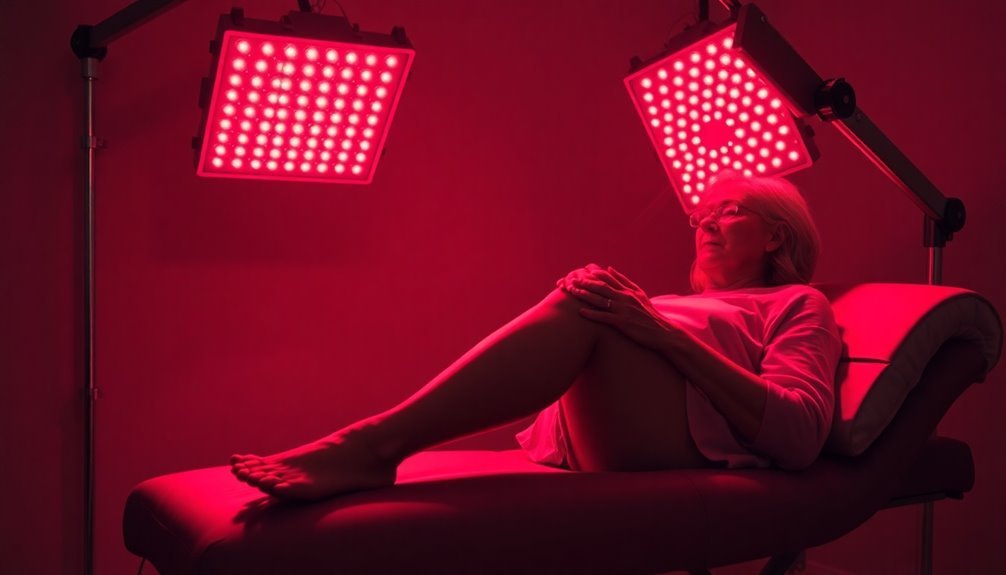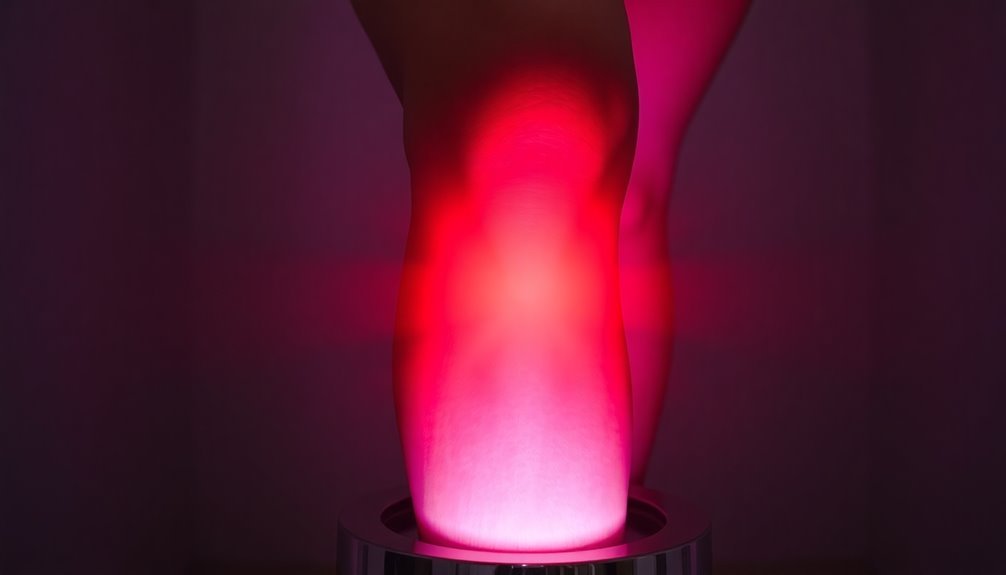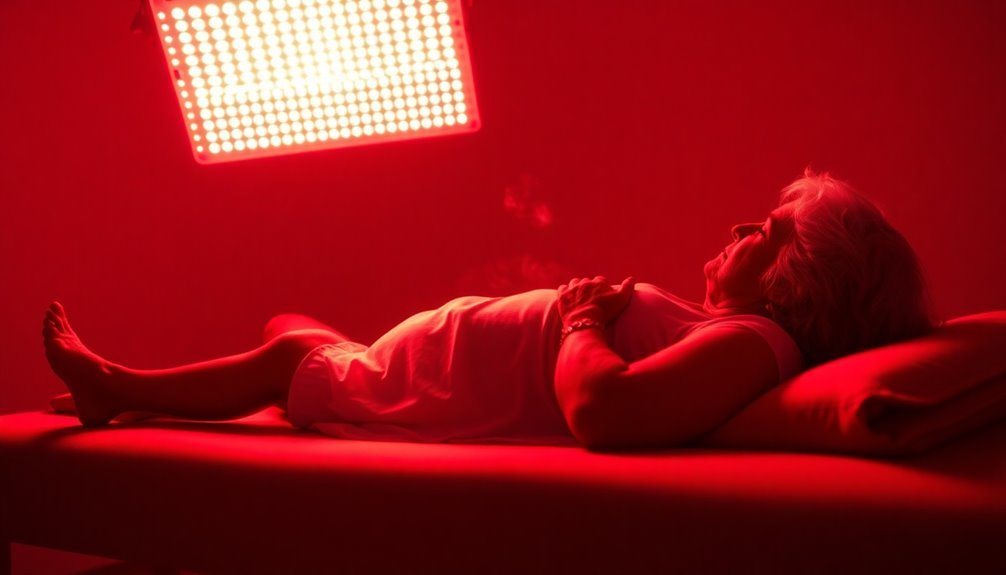Three effective light therapies can help soothe your painful joints. Red light LED treatment penetrates the skin's surface to reduce inflammation and trigger natural healing processes. Near-infrared therapy reaches deeper into joints and tissues, stimulating cellular repair and boosting blood circulation for enhanced pain relief. Combination light wave solutions merge both technologies, offering thorough treatment that targets pain at multiple levels. You'll typically need 5-20 minute sessions, and these FDA-cleared therapies work well alongside other treatments like physical therapy and medication. Discover how these gentle, non-invasive approaches can transform your joint pain management routine.
Red Light LED Treatment

Through recent advances in medical technology, red light LED therapy has emerged as a promising treatment for joint pain and inflammation. This non-invasive treatment uses specific wavelengths of light between 620-750 nm that penetrate deep into your skin, stimulating cellular processes and promoting natural healing.
Clinical studies show impressive results, with patients experiencing more than 50% reduction in arthritis pain. You'll find the therapy particularly effective because it targets joints directly, increasing blood flow and reducing inflammation where you need it most. The therapy enhances mitochondrial function to boost cellular energy production.
The treatment can improve your joint mobility while potentially aiding in cartilage repair and slowing arthritis progression.
You'll appreciate how easy it's to incorporate red light therapy into your daily routine. Using portable devices like the Move+, you can complete treatment sessions in as little as 5 minutes. For the best results, you'll want to maintain consistent use, as regular treatments have shown significant functional improvements in clinical trials.
The therapy works by modulating pain signals and stimulating your cells' natural healing processes, making it an effective solution for various joint pain concerns. Physical therapists worldwide now recommend this treatment, backed by extensive peer-reviewed research.
Near-Infrared Deep Joint Therapy
Innovation in joint therapy has advanced substantially with near-infrared light treatment, operating at wavelengths between 800-850nm that penetrate up to 5 centimeters into your tissues. While invisible to your eye, this deeper penetration reaches muscles and joints that other therapies can't access, making it particularly effective for chronic joint conditions and deep inflammation. Consistent sessions over time can help prevent future joint pain and maintain long-term relief.
Near-infrared light works by triggering your body's natural healing mechanisms. It boosts your cells' energy production through increased ATP, enhances blood circulation, and reduces inflammation in affected areas. The process, known as photobiomodulation, stimulates nitric oxide production, which is essential for cellular health and healing.
You'll find this therapy especially beneficial for managing chronic conditions like arthritis and fibromyalgia. Clinical studies show that when you use near-infrared therapy consistently for 2-4 weeks, you'll likely experience significant pain relief and improved joint function.
It's safe to combine with red light therapy for thorough treatment of both surface and deep tissue issues. While it works well as a standalone treatment, you can safely use it alongside your existing medical treatments for enhanced results.
Combination Light Wave Solutions

Building on the benefits of near-infrared therapy, combining multiple light wavelengths can substantially amplify your treatment results. When you're using combination light therapy, you'll benefit from different wavelengths targeting various depths of tissue simultaneously, maximizing cellular repair and pain relief.
This thorough approach enhances your body's natural healing mechanisms while providing both immediate and long-term relief from joint pain. Regular sessions lasting 20 to 30 minutes deliver optimal therapeutic benefits.
The synergistic effects of combination light therapy offer several distinct advantages:
- You'll experience enhanced ATP production as multiple wavelengths stimulate your mitochondria, boosting cellular energy and accelerating healing.
- Your body will respond with increased endorphin release, providing natural pain relief while reducing inflammation through modulated cytokine levels.
- You'll notice improved joint mobility as different light wavelengths work together to reduce stiffness and increase range of motion.
- Your treatment outcomes will be optimized through complementary wavelengths that promote tissue regeneration at various depths.
You can safely combine this therapy with other treatments, including physical therapy and medication, though it's crucial to consult your healthcare provider first. This non-invasive approach provides FDA-cleared treatment options with minimal risk of side effects or adverse interactions.
Frequently Asked Questions
How Long Does It Take to See Results From Light Therapy Treatments?
You'll notice some immediate relief after your first session, but you won't see lasting results until 1-4 weeks of regular use. For significant long-term benefits, you'll need 3-6 months of consistent treatment.
Can Light Therapy Be Used Alongside Other Arthritis Medications?
Yes, you can safely use light therapy alongside your arthritis medications. There's no known interference between them, and the combination may actually enhance your results compared to using medication alone for pain relief.
Are There Any Age Restrictions for Using Light Therapy Devices?
You'll find most light therapy devices have age restrictions. While some are safe for ages 14+, others require you to be 21+. Always check device guidelines and consult your healthcare provider before use.
Should I Continue Treatment After Symptoms Improve or Stop Completely?
You should continue treatment, but with reduced frequency after symptoms improve. Don't stop completely, as this may cause symptoms to return. Switch to maintenance sessions 2-3 times weekly for sustained benefits.
How Often Should Light Therapy Devices Be Replaced for Optimal Effectiveness?
You'll need to replace your light therapy device every 6-12 months with heavy use, or 1-2 years with light use. Watch for reduced intensity, color changes, or inconsistent performance to determine replacement timing.
In Summary
You'll find these light therapy options offer promising relief for joint pain without invasive procedures. Whether you choose red LED treatments for surface inflammation, near-infrared waves for deeper tissue healing, or combination therapies for thorough care, there's a solution that fits your needs. Don't hesitate to discuss these treatments with your healthcare provider to develop a plan that works best for your joint health.





Leave a Reply